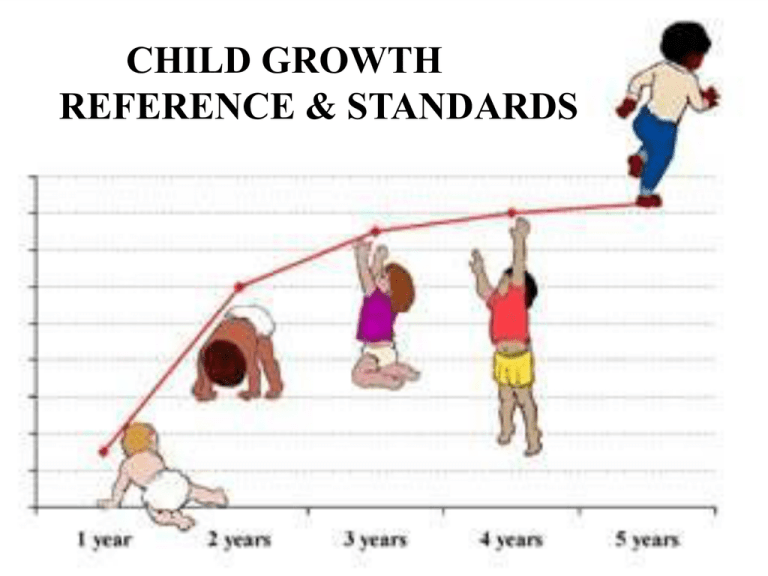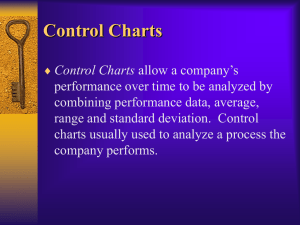
CHILD GROWTH
REFERENCE & STANDARDS
FRAMEWORK
CHILD GROWTH AND GROWTH MONITORING
MEASURES OF SCALES
INDICES FOR ANTHR0POMETRIC ASSESSMENT AND THEIR
INTERPRETATION
DEFINITION OF GROWTH STANDARD AND REFERENCE
REFERENCE OR STANDARD
LOCAL OR INTERNATIONAL
DISTANCE AND VELOCITY STANDARDS
MARGINAL AND CONDITIONAL STANDARDS
PURPOSE OF STANDARDS
HISTORY OF GROWTH REFERENCES AND STANDARDS
WHO MULTICENTRIC GROWTH REFERENCE STUDY
WHAT IS GROWTH ?
regular increase in size or weight
a continuous process
CHILD GROWTH
Growing child is healthy child.
Optimal growth occurs only with a adequate food,
absence of illness, caring and nurturing, social
environment
most rapid in first year of life.
HOW TO MEASURE GROWTH ?
Common anthropometric measurements are
weight, height, MUAC, head circumference, chest
circumference
Most accurate and sensitive method of measuring
growth is weight gain
By regularly weighing
WHAT IS GROWTH MONITORING
Regular monthly recording of weight of the children
and plotting it on the growth chart which enables us to
see the changes in the weight and giving advice to
mother about the growth of child
Purpose:
To take the action against
Inadequate growth in a child
No growth in a child
Weight loss in a child
To restore health & proper growth
ANTHROPOMETRIC ASSESSMENT
- Common anthropometric measurements are
weight, height, MUAC, head circumference,
skinfold thickness (sub-scapular, triceps)
- Indices: for interpretation of measurements.
- Weight-for-age
- Height-for-age
- Weight-for-height
- BMI-for-age
- MUAC-for-age
SCALES OF MEASUREMENTS
Z scores
Percentiles
Percent of median
Z- SCORE OR STANDARD DEVIATION SCORE
The deviation of the value for an individual from the median value of the
reference population, divided by the standard Deviation for the reference
population
(Observed value) - (Median reference value)
Z- Score = -------------------------------------------------------Standard deviation of reference population
•A fixed Z score interval implies a fixed height or weight difference for
children of a given age .
•Advantage:- Allows mean and SD calculation for a group of Z score in
population based applications
PERCENTILE :
The rank position of an individual on a given reference
distribution, stated in terms of what percentage of the group
the individual equals or exceeds .
Eg. A child of a given age whose weight falls in the 10th
percentile weighs the same or more than 10% of the
reference population of children of same age.
Summary statistics not possible
Towards the extremes of the reference distribution there is
little change in percentile values, when there is infact
substantial change in weight or height.
If the distribution of reference values fallows a normal
distribution, percentiles and Z scores are related through a
mathematical transformation.
Commonly used -3,-2 and -1 Z scores are respectively the
0.13th , 2.28th and 15.8th percentiles and the 1st ,3rd and 10th
percentiles correspond to, respectively, the -2.33,-1.88,and 1.29 Z scores.
PERCENT OF MEDIAN:
Ratio of a measured value in the individual, for
instance weight , to the median value of the reference
data for the same age or height, expressed as a
percentage.
•Main disadvantagelack of exact correspondence with a fixed point of
distribution across age and wt status
Eg. Depending on the child’s age, 80% of the median
weight for age might be above or below -2Z score; in
terms of health, it reflects in different classification of
risk.
•Cut off points for percent of median are different for
the different anthropometric indices.
COMPARISON OF THE CHARACTERISTIC OF
THREE MEASURES OF SCALE
Characteristic
Z score
Percentile
Percent of median
Adherence to reference
population
Summary statistics Possible
Yes
Yes
No
Yes
No
Yes
Uniform Criteria across
indices
Useful for detecting changes
at extreme of distribution
Yes
Yes
No
Yes
No
Yes
Comparison between Z- score and Percentile
VARIOUS INDICES
MALNUTRITION:
AND CUT-OFF POINTS FOR DEFINING
__________________________________________________________________________
Indices
Indicators
Cut-off points for defining
for malnutrition
malnutrition
__________________________________________________________________________
Percentile of ref% of referZ or SD from reference median
ence median erence median #
Wt-for-ht
Wasting
< 3rd
< 80%
<-2
Ht-for-age
Stunting
< 3rd
< 90%
<-2
Wt-for-age
Underweight < 3rd
< 80%
< -2
__________________________________________________________________________
“Moderate” malnutrition classified as the percent falling between – 2 to – 3 SD
and “severe” as the percent falls below – 3 SD from the reference median.
INTERPRETATION OF DIFFERENT
INDICATORS
Indicator
Acute
Malnutrition
Chronic
Malnutrition
Wt-for-age
Ht-for-Age
Wt-for-Ht
Normal
Normal
GROWTH STANDARD OR GROWTH
REFERENCE
Dataset representing the distribution of a given
anthropometric measurement as it changes with
some covariate - usually age - in the two sexes,
based on a specified reference sample of children.
REFERENCE OR STANDARD
‘Growth Standard’
Represents the quality of growth. It represent
‘good’ growth, i.e. a norm to aspire to.
Using a growth standard as a norm implies that
it represents optimal growth
‘Reference growth’
Yardstick to be used for comparison purposes.
It provides a reference, not a norm.
LOCAL OR INTERNATIONAL
International standard ( NCHS standard, New
WHO Growth standards)
Advantage- Simplifies comparisons between regions
or countries
Disadvantage - pattern of growth shown by the
standard may be quite inappropriate in particular
regions of the world, for example India, where the
children are considerably smaller than in the USA.
Local standard (ICMR chart, Agrawal KN chart)
More appropriate if clinical decisions are needed
if a statistical analysis is used to adjust
anthropometry for age.
DISTANCE AND VELOCITY
STANDARDS
Distance standards (Tanner,1962)
Distance standard marked with an extra set of
centile-like curves which indicate how much a
child’s centile can be expected to change over a
given time period.
a one-off measure is used, based on a single
measurement, which gives no clues as to the
growth pattern that has led the child to its
current position.
It indicates only how extreme the child is in
terms of current size or status.
DISTANCE AND VELOCITY
STANDARDS
Velocity standards (Emery et al, 1985)
Velocity standard is a tool to quantify changes in
measurement centile over time.
Standards based on growth measured over a
period of time
Measures growth rather than status
Require two measurements instead of one
Need to be constructed using longitudinal data.
More sensitive in correctly identifying ill children
as it changes more rapidly during growth failure.
MARGINAL AND CONDITIONAL
STANDARDS
Marginal or unconditional standards
Most common form of standard
Constructed from a reference population where each
individual contributes a single measurement, unadjusted for
other information.
Expresses individual subjects in terms of a centile relative to
the reference population on which the standard is based.
Can be applied equally to distance and velocity - individuals
from the reference population provide either a single
measurement or a single velocity.
Velocity standards in infancy tend to be unconditional
although in practice such infants are followed longitudinally,
and often provide several velocity measurements.
MARGINAL AND CONDITIONAL
STANDARDS
Conditional standards
It works on the principle that a child's measurement
should be expressed conditional on, or adjusted for,
another covariate in addition to age and sex.
Described for height and height velocity during
puberty adjusted for tempo (Tempoconditional or
clinical longitudinal standards).
It reduces the variability of the measurement.
Require a strong correlation between the
measurement and the conditioning variable.
Conditional predictions for individuals in the tails of
the distribution are unbiased, whereas velocity
standard predictions are often biased.
The statistical advantage of the conditional standard
is that it can be extended naturally to a full
regression model with other covariates.
Distance growth chart showing conditional and unconditional
standards
Age(years)
Velocity growth chart showing conditional and unconditional
standards
PURPOSE OF STANDARDS
Screening
Anthropometry is widely used as a screening tool
for disease in children and adults.
Screening involves identifying individuals below
some prespecified cut-off, on the assumption that
their chance of being ill is greater than for the
population as a whole.
Velocity screening during infancy is valuable for
identifying failure to thrive.
PURPOSE OF STANDARDS
Clinical
Height velocity is of particular value is the specialist
growth clinic.
Conditional standard approach is more appropriate than a
velocity Standard in growth clinic.
Group summary
Anthropometry is often used to summarize the growth
status of groups, with the aim of identifying groups at
particular risk of growth faltering.
Use of a growth standard enables distinct age-sex ranges
to be combined, which increases the ability to summarize
the results.
Education
Providing mothers with information about their child’s
health through charts such as the ‘Road to health’ chart.
BACKGROUND & HISTORY
Galton (1885) - Invented anthropometric
percentiles
Bowditch (1891) published the first account of
growth standards, using curves based on Galton’s
percentiles
Meredith (1940) at Iowa- Pioneer growth
standards
Harvard Growth Curves (1960-70)
Tanner Growth Curve (1960-70)
NCHS/CDC Growth curves (1974)
New WHO Growth Charts (1993)
HARVARD GROWTH CURVES (1960-70)
In
1966, WHO simplified the Harvard growth curve by
introducing the combined sexes version
International growth reference
Reference data from caucasian children in Boston
children’s hospital (1930-56)
Hospital based
Longitudinal study
Small sample size
Top fed babies
Still served the purpose of creating an awareness and
need for monitoring & growth assessment
Used in Indian growth charts & for classification of
malnutrition since mid 1970s (50th centile taken as
100%)
CDC GROWTH CHARTS
NCHS
growth charts based on growth of
American children developed in 1977
Adopted by WHO for international use
CDC 2000 growth charts a revised version
of earlier NCHS chart: Revision of previous
existing 14 charts with introduction of 2
new BMI charts
No new primary data collected
Used national studies conducted at various
times & places and improved statistical
tools
CDC 2000 GROWTH CHARTS:
NEW FEATURES
Addition
of BMI for age charts: 2 – 20 years
Addition of 85th centile on BMI for age & wt
for stature charts
Addition of 3rd & 97th centiles
Limits of length & stature extended on wt
for length & wt for stature charts
Smoothened percentile curves & Z scores
Correction of disjunction that occurred
between 24 & 36 months when switching
from length to stature in NCHS charts
CDC: CHARTS AVAILABLE
Birth – 36 months
2 - 20 years
2-5 years
Length & weight for age
Head circumference for age
Weight for length
Stature & weight for age
BMI for age
Weight for stature
NEW WHO GROWTH STANDARDS
The international growth standards established by the WHO in
April 2006 directly confront the notion that ethnicity is a major
factor in how children grow. The new standards demonstrate
that children born in different regions of the world , when
given an optimum start in life , have the potential to grow and
develop within the same range of height and weight for age.
(ECHUI 2006 Global Framework for Action)
Rationale for change to new WHO standards
NCHS/WHO international reference is inappropriate for
assessing nutritional status:
•Individual
interferes with sound nutritional management of breastfed
infants, increasing their risk of morbidity and mortality
•Populations
provides inaccurate estimates of undernutrition and
overweight
New WHO standards Corrects
the historical fallacy of
using formula fed children from single ethnic group in one
country as global standard for assessment of nutritional status
of preschool children and consequent problems in interpretation
of data .
WHY SHOULD WE ADOPT NEW
CHARTS?
The new Child Growth Standards is a
crucial development in improving infant and
young child nutrition globally. Unlike the old
growth charts, the new standards
describe how children "should grow,"
establish breastfeeding as the biological "norm,”
provide international standards for all healthy
children, as human milk supports not only
healthy growth, but also optimal cognitive
development and long-term health.
The WHO Multicentre
Growth Reference
Study
(1997-2003)
WHO GROWTH REFERENCE STUDY
PRESCRIPTIVE APPROACH
Optimal Nutrition
Optimal Environment
Breastfed infants
Appropriate complementary feeding
No microbiological contamination
No smoking
Optimal Health Care
Immunization
Pediatric routines
Optimal
Growth
MGRS STUDY DESIGN
Longitudinal (0-24
months)
year 1
year 2
year 3
Cross-sectional (18-71 mo)
MGRS STUDY DESIGN AND SAMPLE
Eligibility Criteria for Individuals
No health, environmental or economic constraints on growth
• Mother willing to follow feeding recommendations:
Exclusive/ predominant breast feeding for 1st 4 mths,
introduction of complementary feeding by 6 mths
• Term, single birth
• Lack of significant perinatal morbidity
• Non smoking mothers before and after delivery
MGRS STUDY DESIGN AND SAMPLE
Longitudinal study (birth-24 months)
Mothers
& newborns screened & enrolled at
birth
Weight, length, head circumference: 21
times over 24 months
Arm circumference: 10 times between 3 and
12 months
Skin fold thickness : 6 times between 14
and 24 months
MGRS STUDY DESIGN AND SAMPLE
Cross-sectional survey (18-71 mo)
Weight, length, head circumference, arm
circumference, skin fold thickness
Total sample 8440 children from 6 countries
300
newborns per site (1743 total) followed
up till 24 mo from the longitudinal study
1400
children per site (6647 total) aged 1871 mo through the cross sectional surveys
CONSTRUCTION OF GROWTH CURVES
The rigorous methods of data collection yielded very highquality dataset
State-of-art statistical methods applied in a methodical way:
Detailed examination of 30 existing methods, including types of
distributions and smoothing techniques;
Selection of a software package flexible enough to allow
comparative testing of alternative methods and the actual
generation of the curves;
Systematic application of the selected approach to the data to
generate models that resulted in the best fit
WHO CHILD GROWTH STANDARDS
•
Attained growth
Weight-for-age
Length/height-for-age
Weight-for-length/height
Body mass index-for-age
Mid-upper arm circumferencefor-age
• Triceps skinfold-for-age
• Subscapular skinfold-for- age
• Head circumference-for-age
•
•
•
•
•
•
Growth velocity
•
•
•
•
Weight
Length/height
Head circumference
Arm circumference
COMPARISON OF EXISTING GROWTH
CHARTS
Data charact
CDC
Source
Multiple different
studies
Study period
Population
Age-group
1963-1994
US, mixed
feeding, no
racial/ethnic diff
Birth-20 yrs
WHO
Primary data
1997-2003
6 Countries pooled
data. healthy
breastfed children
Birth-5yrs
WHO STANDARDS VERSUS NCHS REFERENCE
Important differences that vary by age group, sex,
growth indicator, specific percentile or z-score
curve, and the nutritional status of index
populations.
Differences are particularly important during
infancy due to type of feeding and issues related to
study design (eg, measurement interval)
Difference in shapes of the weight-based curves in
early infancy makes interpretation of growth
performance strikingly different depending on
whether the WHO standard or the NCHS reference
is used
Healthy breastfed infants track along the WHO
weight-for-age mean z-score while appearing to
falter in NCHS from 2 months onwards –
implications assessment of lactation performance
and adequacy of infant feeding
Mean weight-for-age z-scores of healthy breastfed
infants relative to the NCHS, CDC and WHO curves
Mean weight-for-age z-score
CDC
0. 8
NCHS
MGRS
0. 4
0
-0. 4
-0. 8
0
1
2
3
4
5
6
7
Age (months)
8
9
10
11
12
Comparison of WHO with NCHS and CDC chart
PREVALENCE OF STUNTING (BELOW -2 SD LENGTH/HEIGHT-FOR-AGE) BY AGE
BASED ON THE WHO STANDARDS AND THE NCHS REFERENCE IN BANGLADESH
NCHS
WHO
80
70
60
%
50
40
30
20
10
0
0-5
6-11
12-23
24-35
Age (months)
36-47
48-60
0-60
PREVALENCE OF UNDERWEIGHT (BELOW -2 SD WEIGHT-FOR-AGE) BY AGE BASED
ON THE WHO STANDARDS AND THE NCHS REFERENCE IN BANGLADESH
NCHS
WHO
80
70
60
%
50
40
30
20
10
0
0-5
6-11
12-23
24-35
Age (months)
36-47
48-60
0-60
GROWTH CHARTS
Consist of a series of percentile curves that
illustrate the distribution of selected body
measurements in the study population
Used to track the growth of children from infancy
thru adolescence
Indicates the state of the child's health, nutrition
and well being
References:
1.World Health Organization. WHO child growth standards: length/height-forage, weight-for-length, weight for height, and body mass index for age:
methods & development. Geneva. World Health Organization. 2006
2.World Health Organization. Physical Status: The use and interpretation of
anthropometry. WHO Technical Report Series 854. Geneva. World Health
Organization; 1995. P. 418, 422-23.
3.Cole TJ. The use and construction of anthropometric growth reference
standards. Nutrition Research Reviews,1993(6):19-50
4. Mercedes O, Ray Y. The WHO Growth Chart: Historical consideration and
current scientific issues. Bibl Nutr Dieta;1996(53):pp 74-89
5. Onis M, Onyango AW, Borghi1 E, Garza C and Yang H. Comparison of the
World Health Organization (WHO) Child Growth Standards and the
National Center for Health Statistics/WHO international growth reference:
implications for child health programmes. Public Health
Nutrition,2006;9(7):942–947







